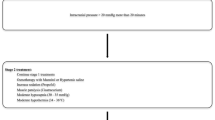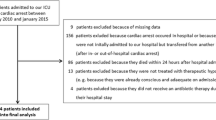Summary
Nosocomial infections diminish the prognosis and clinical outcome of patients with acute stroke. This retrospective study was performed to investigate epidemiological data and risk factors for the development of nosocomial pneumonia in 50 patients (25 supra- and 25 infratentorial acute infarctions) treated in a neurological ICU. A total pneumonia incidence of 42% (21/150) was observed. In 19 cases (85%), the diagnostic criteria of early-onset pneumonia were fulfilled, and 15 of 19 patients were mechanically ventilated. The incidence of pneumonia was significantly higher in infratentorial infarctions. Compared to supratentorial ischemic lesions, patients with HI-infra presented with a significant higher disturbance of consciousness (assessed with the Glasgow Coma Scale) and severity of the disease (assessed with the APACHE II Scale). Besides poor performance in GCS and APACHE II, the necessity of early endotracheal intubation and the presence of infratentorial infarction were identified as risk factors for nosocomial pneumonia in acute stroke. Our results demonstrate the pathogenetic relevance of altered consciousness presumably leading to tracheal aspiration. For clinical concerns, stroke patients with infratentorial infarction and impaired consciousness should be classified as a high-risk group and receive intensive prophylactic treatment.
Zusammenfassung
Die Gesamtprognose von Patienten mit ischämischem Hirninfarkt ist wesentlich vom Auftreten infektiöser Sekundärkomplikationen abhängig. Wir untersuchten retrospektiv jeweils 25 auf einer neurologischen Intensivstation behandelte Patienten mit supra-(HI-supra) und infratentoriellem Hirninfarkt (HI-infra) im Hinblick auf epidemiologische Daten und Risikofaktoren einer nosokomialen Pneumonie. Es fand sich eine Gesamtinzidenz der Erkrankung von 42% (21/50), wobei 85% der Fälle (19/21) einer early-onset-Pneumonie zuzuordnen waren. Insgesamt 15 Pneumonie-Patienten wurden intubiert und mechanisch ventiliert. Patienten mit HI-infra wiesen im Vergleich zu den HI-supra nach 24 bzw. 48 Stunden eine signifikant größere Bewußtseinsstörung und allgemeine Erkrankungsschwere auf (quantifiziert mit GCS und APACHE II) und entwickelten signifikant häufiger eine Pneumonie. Als Risikofaktoren für das Auftreten der Erkrankung bei akutem Hirninfarkt ermittelten wir die Notwendigkeit einer Frühintubation (Relatives Risiko = RR 5,6; 95%-Konfidenzintervall = CI 2,18–14,50), das Vorliegen eines infratentoriellen Infarktes (RR 2,17; CI 0,98–4,79) sowie ungünstige Befundkonstellationen in GCS (<10 Punkte) und APACHE II (>10 Punkte) in den ersten 48 Behandlungsstunden. Die Einzelanalyse der Ergebnisse zeigte die Bedeutung einer initialen Bewußtseinsstörung für die Entwicklung einer nosokomialen Pneumonie bei akutem Hirninfarkt. Aus diesen Daten läßt sich folgern, daß insbesondere bewußtseinsgeminderte Patienten mit infratentoriellem Insult gefährdet sind, eine Pneumonie zu entwickeln. Pathogenetisch dürfte eine tracheale Makroaspiration infolge der bei Bewußtseinsstörungen verminderten laryngealen Schutzreflexe für den Großteil der Erkrankungsfälle verantwortlich sein. Konzepte zur Pneumonieprophylaxe bei Hirninfarkt sollten daher insbesondere bei den genannten Risikopatienten berücksichtigt werden und auf die Aspirationsverhinderung ausgerichtet sein.
Similar content being viewed by others
Author information
Authors and Affiliations
Additional information
Eingegangen: 16. März 1999 Akzeptiert: 12. April 1999
Rights and permissions
About this article
Cite this article
Hilker, R., Zakzuk, M., Schneweis, S. et al. Nosokomiale Pneumonie nach akutem ischämischen Hirninsult: Evaluation von Inzidenz und Risikofaktoren in der neurologischen Intensivmedizin. Intensivmed 36, 526–533 (1999). https://doi.org/10.1007/s003900050272
Issue Date:
DOI: https://doi.org/10.1007/s003900050272




